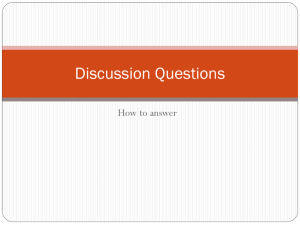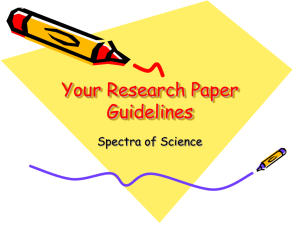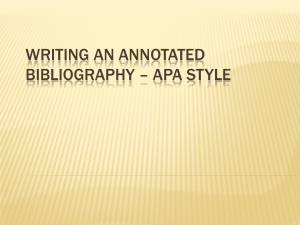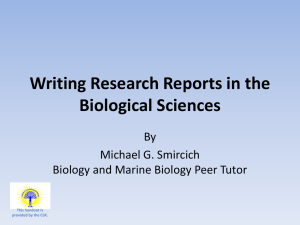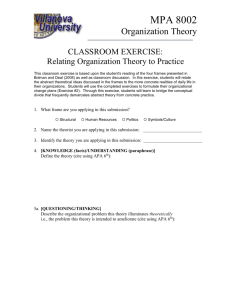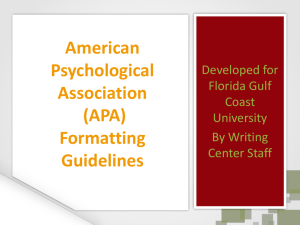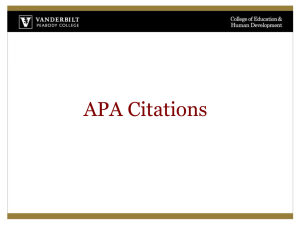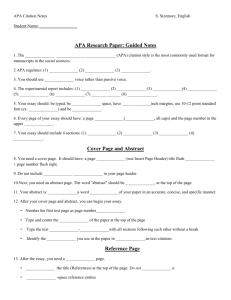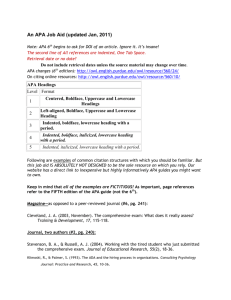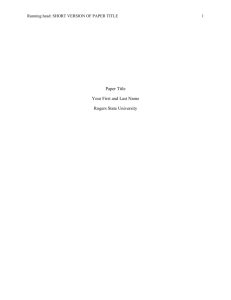APA Workshop - California Lutheran University
advertisement
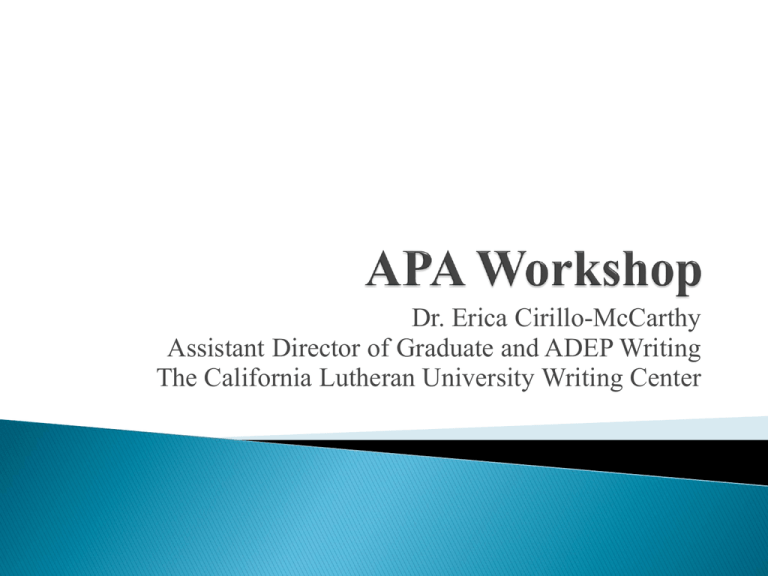
Dr. Erica Cirillo-McCarthy Assistant Director of Graduate and ADEP Writing The California Lutheran University Writing Center Why cite? Integrating sources Three components of APA: attribution phrase, in text citation, reference list Attribution phrases Examples of in text citations Guidelines for the reference list APA guidelines to address at the revision stage APA resources “Provide readers with cues they can use to follow your ideas more efficiently and to locate information of interest to them Allow readers to focus more on your ideas by not distracting them with unfamiliar formatting Establish your credibility or ethos in the field by demonstrating an awareness of your audience and their needs as fellow researchers” (OWL Purdue, 2012) Summary – a clear statement of the main idea/purpose/hypothesis/methodology of a study written in the reader’s own words. Paraphrase – a much more focused articulation of an idea/purpose/hypothesis/methodology in a study written in the reader’s own words. Quotation – must have a clear introduction and contextualization. Whether you quote, paraphrase, or summarize…. Whether it’s an idea, a thought, a definition, a theory, or a methodology, if it was first articulated by someone else…. YOU MUST CITE YOUR SOURCE! Attribution phrase – a signal phrase used to tell the reader that we are about to introduce a quote, summary, or paraphrase of someone else’s idea, words, research, theories, or methodologies. In text – when we refer to our sources’ ideas, words, research, theories, methodologies in the main body of our papers, we follow a specific format which allows the reader to quickly find the full citation located on the references list. For APA, we call this the author date format, meaning both the author and the date of publication (if you have it) of the text cited will be in the included in the sentence of cited material. References List – the list of all sources referred to in our papers, listed in a specific way so that readers can easily refer to a source if they choose to do so. Helps the reader understand that the next bit of information comes from a source other than the writer Looks like this: According to Smith (2011), students who utilize writing support increase their independence and confidence in writing. (PARAPHRASE) Smith’s study (2011) argues for increased writing support for graduate students. (SUMMARY) Smith (2011) finds that “writing support services have a direct effect on student writing…” (p 234). (DIRECT QUOTE) Verbs Used in Attribution Phrases The verb you choose for an attribution (or signal) phrase should accurately reflect the intention of the source. acknowledges concedes illustrates reports admits concludes implies reveals agrees declares insists says argues denies maintains shows believes endorses observes suggests claims finds points out thinks comments grants refutes writes Two ways to cite one work by 1 author ◦ Walker (2000) compared reaction times OR ◦ In a recent study of reaction times (Walker, 2000), Two ways to cite one work by 2 authors ◦ Walker and Smith (2000) compared reaction times OR ◦ In a study of reaction times (Walker & Smith, 2000), One work by 3, 4, or 5 authors: ◦ First reference in the paragraph will give all names, and subsequent references in the same paragraph will use “et al.” (no italics and with period after “al”) Wader, Rosen, and Rock (1994) found (1st citation) Wader et al. (1994) found (2nd citation in paragraph) Wader et al. found (subsequent citations in paragraph) One work by 6 or more authors: ◦ Cite only the surname of the first author and “et al.” with the year for all citations Quotations must be cited by author, year, and page number (p. 213) or paragraph number (¶ 4) for html articles ◦ Ex.: (Oksuta, 2003, p. 57) ◦ Ex.: (Feingold, 1989, ¶ 16) ◦ Ex. (Feingold, 1989, Conclusion section, para. 6) Alphabetical by first author’s surname Multiple works by the same author are ordered by year of publication, with the earliest first One-author entries precede multiple-author entries beginning with the same surname If there is no author, use the title of the piece. Use (n.d.) if no date is given Commas ◦ Set off year from author in parenthetical reference (Miller, 1997) Quotation marks ◦ For verbatim material from an outside source ◦ Use double quotes (“normal” behavior) for invented and coined expressions, but only the first time used Semicolon ◦ Separate multiple parenthetical references (Johnson, 1987; Sacks & Wheaton, 1992) Yes it is! APA style has specific guidelines on the following stylistic decisions: ◦ Use active voice and first person: Ex. We conducted experiments….(not “experiments were conducted…”) ◦ Strive for clarity and concision: Be specific for your audience: who did what? How did they do it? Why did they do it? What was the end result? Revise for clear, declarative sentences ◦ Avoid poetic language: No metaphoric images If you have a choice between two words, go for the one that is most clear and uniformly understood, not because it sounds smart, verbose, or flowery When you are doing the final formatting, look at the following sections and refer back to the APA style guide: Title page and abstract Paragraphs and headings Abbreviations Mathematics and statistics Units of measurement References Notes and footnotes Tables and figures Copyright and quotations Make an appointment at the Writing Center to sit with a tutor who can show you how to use the reference guide: http://www.callutheran.edu/writing_center Head to this great website: http://owl.english.purdue.edu and click on APA format and style guidelines Buy or borrow the most current APA Style Guide from the library, the CLU bookstore, or your favorite online used book resource Questions? Thank you! Please visit the CLU Writing Center in the Pearson Library: www.callutheran.edu/writing_center Purdue University Online Writing Lab. (n.d.) APA Style. Purdue Online Writing Lab. Retrieved from http://owl.english.purdue.edu/owl/resource/560/01/. Rasmussen, K. (2003). A writer's guide to research and documentation (5th ed.). Upper Saddle River, NJ: Prentice Hall.
